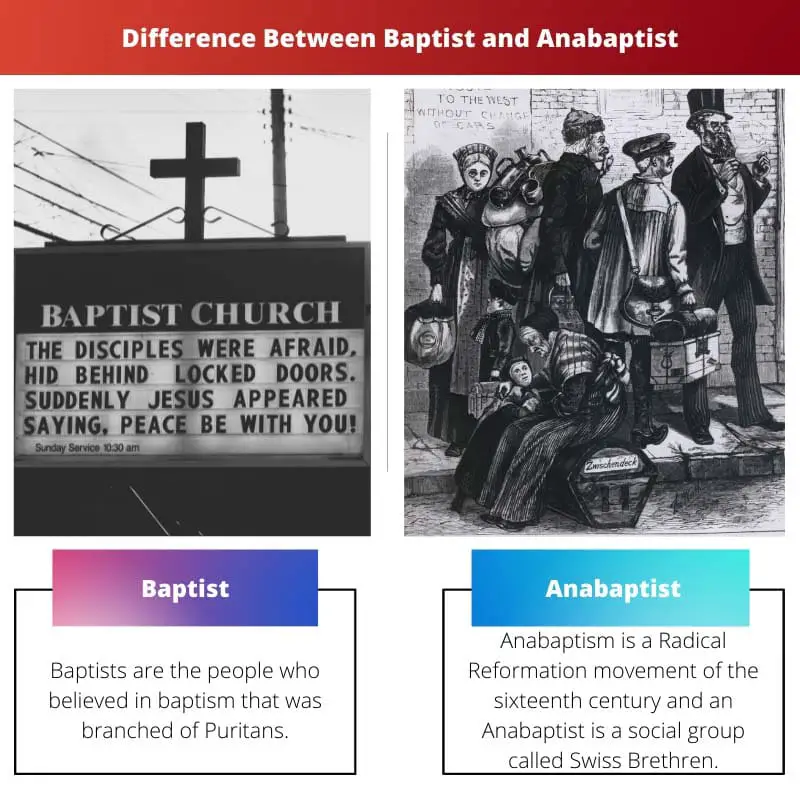Baptists practice believer’s baptism and emphasize individual freedom in interpreting scripture, while Anabaptists historically advocate for adult baptism, nonviolence, and communal living, tracing their roots to the Radical Reformation.
Key Takeaways
- Baptists are a group of Christians who believe in baptism by immersion, while Anabaptists reject infant baptism and baptize only adults.
- Anabaptists believe in the separation of church and state, while Baptists hold various beliefs.
- Baptists are more mainstream and well-known than Anabaptists, seen as a smaller, more radical group.
Baptist vs Anabaptist
The difference between Baptists and Anabaptists is that Baptists believe they cannot control and impose one’s freedom as it is their right. In contrast, Anabaptists do not believe in this and impose rules to be followed by all the sect members.

Baptist is the people who believe in and follow baptism, which is a branch of the Puritans. They do not have one belief as it depends on the groups or the places where they live.
They mingle with other societies and actively participate in their political aspects and military services. Anabaptists are people of the Anabaptism, a revolutionary movement of the sixteenth century.
Like Baptists, they also rejected infant baptism and propagated pacifism. They are the ones who believe that rules of simplicity are to be followed by all the members of the sect and live secluded from the rest.
Comparison Table
| Feature | Baptist | Anabaptist |
|---|---|---|
| Origin | Emerged in England in the 17th century | Emerged in continental Europe in the 16th century |
| Historical Context | Part of the Protestant Reformation, but distinct from Lutherans, Calvinists, and other established churches | Part of the Radical Reformation, challenging some mainstream Protestant and Catholic doctrines |
| Baptism | Believers’ baptism (immersion) only | Believers’ baptism (immersion) only |
| Church Membership | Believers’ church (individuals make conscious decision to join) | Believer’s church (individuals make conscious decision to join) |
| Separation of Church and State | Generally advocate for separation | Often advocate for separation |
| Pacifism | Varies. Some denominations, like Mennonites, practice pacifism. Others do not. | Many traditional Anabaptists practice pacifism, although some groups have adopted more nuanced stances. |
| Social Practices | Varies across denominations. Some maintain traditional dress codes and practices. Others are more integrated into mainstream society. | Traditionally, many Anabaptist groups maintained distinct dress codes, communal living, and separation from worldly activities. Today, these practices vary considerably. |
| Denominations | Southern Baptist Convention, National Baptist Convention, American Baptist Churches USA, etc. | Mennonites, Amish, Hutterites, Quakers, etc. |
What is Baptist?
Baptist is a Christian denomination characterized by its emphasis on believer’s baptism, congregational governance, and the autonomy of local churches.
Beliefs and Practices
- Believer’s Baptism: One of the central tenets of Baptist theology is the practice of believer’s baptism, wherein individuals publicly profess their faith and are immersed in water. This act symbolizes spiritual rebirth and personal commitment to Christ.
- Congregational Governance: Baptists adhere to a congregational form of church government, where each local church is self-governing and independent, with authority vested in its members rather than a hierarchical structure.
- Priesthood of All Believers: They affirm the priesthood of all believers, emphasizing the direct access of each individual to God and the responsibility of every believer to interpret scripture and participate in the life of the church.
- Sola Scriptura: Baptists uphold the principle of sola scriptura, meaning they regard the Bible as the ultimate authority for faith and practice, guiding their beliefs and actions.
- Evangelism and Mission: Many Baptists prioritize evangelism and missionary work, seeking to spread the message of salvation and make disciples of all nations.
Historical Development
The Baptist tradition traces its roots to the 17th century English Separatist movement and the influence of figures like John Smyth and Thomas Helwys. The denomination grew amidst religious persecution and dissent, with early Baptist congregations forming in England and later spreading to the American colonies.
Denominational Diversity
Baptist churches vary widely in their theological perspectives, worship styles, and social practices. While some adhere closely to traditional beliefs and practices, others embrace more liberal interpretations and engage in social justice initiatives.
Key Figures
Notable figures in Baptist history include Roger Williams, who founded the first Baptist church in America in Rhode Island, and Charles Spurgeon, a prominent preacher in the 19th century known as the “Prince of Preachers.”
Contemporary Issues
In recent years, Baptists have grappled with issues such as gender roles in ministry, LGBTQ+ inclusion, racial reconciliation, and the intersection of faith and politics, reflecting broader societal debates within the Christian community.

What is Anabaptist?
Anabaptism is a Christian movement that emerged during the 16th-century Radical Reformation, advocating for adult baptism and emphasizing discipleship, nonviolence, and communal living.
Beliefs and Practices
- Adult Baptism: Anabaptists reject infant baptism, instead advocating for believer’s baptism administered to adults who make a conscious decision to follow Christ. This baptism symbolizes a personal commitment to discipleship and Christian community.
- Discipleship and Nonviolence: Anabaptists prioritize following Jesus’ teachings on love, nonviolence, and forgiveness. They reject participation in military service and promote peaceful resolutions to conflicts.
- Community of Believers: Anabaptist communities emphasize communal living, where members share resources, support one another, and strive for simplicity in lifestyle. This communal ethos extends to decision-making processes within the church, employing consensus-based decision-making rather than hierarchical structures.
- Separation of Church and State: Historically, Anabaptists have advocated for the separation of church and state, resisting state control over matters of faith and affirming the autonomy of the church.
Historical Development
The Anabaptist movement emerged in the 16th century as a response to the perceived corruption of the Roman Catholic Church and the Reformers’ failure to fully reform the church according to New Testament principles. Key figures in the movement include Conrad Grebel, Felix Manz, and Menno Simons.
Denominational Diversity
Anabaptism encompasses various denominations and communities, including the Mennonites, Hutterites, and Amish, each with distinct theological emphases and cultural practices. While they share core Anabaptist principles, they differ in their approaches to technology, dress, and engagement with modern society.
Key Figures
Menno Simons, an ex-Catholic priest, became a prominent leader in the Anabaptist movement and lent his name to the Mennonite denomination. Other influential figures include Jakob Hutter, founder of the Hutterite community, and Jacob Amman, who led a schism resulting in the formation of the Amish movement.
Contemporary Issues
Modern Anabaptist communities grapple with issues such as maintaining traditional practices in a rapidly changing world, engaging with technology while preserving community values, and navigating relationships with mainstream society while upholding distinct theological convictions. Additionally, there are ongoing discussions about inclusivity, social justice, and the relevance of Anabaptist principles in the 21st century.

Main Differences Between Baptist and Anabaptist
- Approach to Baptism:
- Baptist: Accepts believer’s baptism, administered to adults who have made a personal profession of faith.
- Anabaptist: Rejects infant baptism, advocates for adult baptism as a conscious choice made by individuals committed to following Christ.
- View on Church Governance:
- Baptist: Often adheres to congregational governance, with autonomy granted to individual local churches and decisions made by the congregation.
- Anabaptist: Emphasizes communal decision-making within the church community, employing consensus-based processes and rejecting hierarchical structures.
- Stance on Nonviolence and Pacifism:
- Baptist: While individual Baptist congregations may vary, Baptists do not have a consistent stance on pacifism, and some may support participation in military service.
- Anabaptist: Strongly emphasizes nonviolence and pacifism, rejecting participation in war and advocating for peaceful resolutions to conflicts.
- Engagement with Society:
- Baptist: Often engaged in evangelism and missionary work, focusing on spreading the Christian message and making disciples.
- Anabaptist: Prioritizes living out Christian principles in community, emphasizing simplicity, mutual support, and separation from worldly influences.
- Historical Origins:
- Baptist: Emerged from the English Separatist movement in the 17th century and later spread to the American colonies.
- Anabaptist: Originated during the Radical Reformation of the 16th century, as a response to perceived corruption in both the Roman Catholic Church and the Protestant Reformers’ efforts.

The conclusion of the two groups is because of their origin. Baptists believe in baptism, a branch of the Puritans, whereas Anabaptism, followed by Anabaptists, was started in the sixteenth century as a Radical Reformation.




